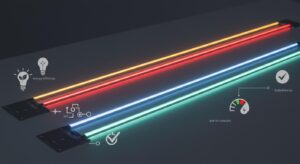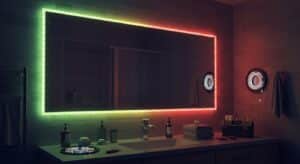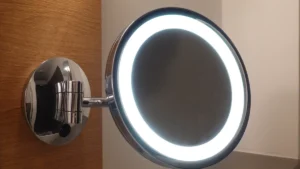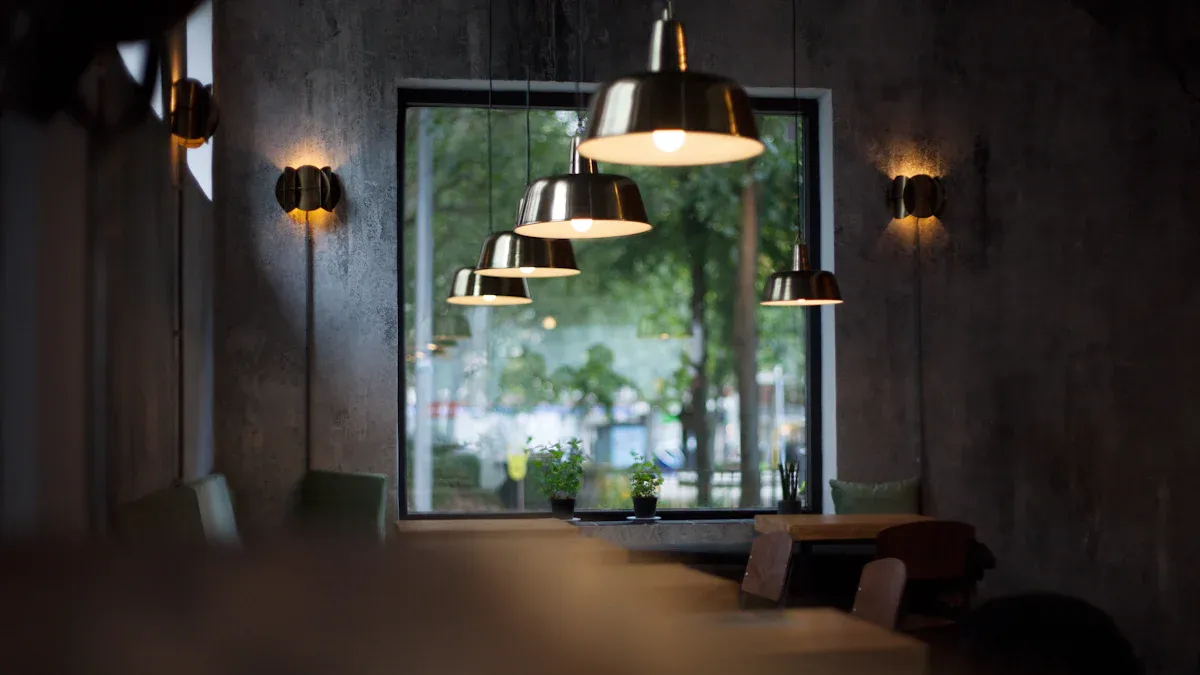
LED modules are small, all-in-one parts made for bright lighting. They are important in modern lighting because they work well in homes, businesses, and factories. These modules use advanced LED chips to give steady, good-quality light.
You might ask why LED modules are so popular. The reasons are clear. They use up to 90% less energy than old lights, saving money on electricity. They last over 50,000 hours, so you don’t replace them often. Also, the global market for LED chips and modules is expected to grow from USD 26.34 billion in 2023 to USD 62.12 billion by 2032. This shows how useful and liked they are.
Key Takeaways
LED modules use up to 90% less energy than old bulbs, cutting electricity bills.
Picking LED modules with a high Colour Rendering Index (CRI) makes colours look better and improves how spaces feel.
Knowing about colour temperature helps you choose the best light for each room, setting the right mood.
Good heat control in LED modules makes them last longer and stay bright.
Always look for certifications like CE and RoHS to make sure LED modules are safe and good quality before buying.
Key Features of LED Modules

Luminous efficiency and energy savings
LED modules are great at saving energy. They are very efficient at turning electricity into light. This is called luminous efficiency. Modern LED modules can give over 100 lumens per watt (lm/W). Some advanced ones even go beyond 200 lm/W. This means they use less power but shine brighter than old lights.
LED modules save a lot of energy. For example:
They use up to 90% less power than old bulbs.
A study found they cut energy use by 75.65% when replacing regular lamps.
Since 2010, LED efficiency has improved by about 4 lm/W every year.
These improvements lower electricity costs and help the environment. To meet Net Zero goals, LED efficiency must reach 140 lm/W by 2030. That’s 30% better than in 2022. By using LED modules, you save money and help the planet.
CRI and colour accuracy
CRI, or Colour Rendering Index, is another key feature of LED modules. It shows how well a light shows the true colours of things. CRI scores go from 0 to 100. Higher scores mean better colour accuracy. For most lights, a CRI of 80 or more is best for natural-looking colours.
High CRI lights have many benefits:
They make objects look more real and clear.
They help you see better when working or studying.
They can even improve your mood by making spaces feel nicer.
For shops, a CRI of 75 or more is good. For homes, a CRI of 70 works well. Choosing LED modules with high CRI gives better colours and a nicer lighting experience.
Colour temperature and its applications
Colour temperature, measured in Kelvin (K), shows how light looks. It can be warm yellow or cool blue. Knowing this helps you pick the right light for each space.
Warm white light (2700K-3000K): Great for cosy spaces like bedrooms or living rooms.
Neutral white light (3500K-4500K): Good for kitchens, bathrooms, or offices needing balanced light.
Cool white light (5000K-6500K): Best for work areas like garages or hospitals, as it helps focus.
Picking the right colour temperature lets you create the perfect mood. LED modules offer many choices, making them useful for all kinds of spaces.
Heat dissipation and longevity
Getting rid of heat is key for LED modules to work well. LEDs make heat when they turn electricity into light. If this heat isn’t managed, it can build up. This lowers efficiency and wears out parts faster.
Why is heat control so important? Studies show that a 20°C rise in heat can cut LED life by six times. High heat also makes lights dim over time. In powerful LED systems, heat can go over 100 watts per square centimetre. So, good heat control is needed to keep LEDs working longer.
Manufacturers use smart ways to handle heat. Soldering moves heat away better than glue. Sintering, which joins materials with high heat, is great for thin LEDs. These methods stop heat from harming important parts.
Labs test how well LEDs handle heat. Two common tests are:
Test Method | What It Does |
|---|---|
Thermographic Analysis | Uses special cameras to find hot spots on the surface. |
Temperature Cycling Test | Checks performance by switching between hot and cold conditions. |
These tests show if an LED can manage heat and work reliably.
Bad heat control causes problems. Temperatures over 85°C speed up wear and tear. This makes LEDs less bright, changes colours, and shortens their life. Picking LEDs with good heat control means better, longer-lasting lights.
Performance Metrics of LED Modules
Wattage and energy use
When picking LED modules, know wattage and energy use. Wattage shows how much power an LED uses, measured in watts (W). Lower wattage often means less energy used, but not always less brightness. Instead, focus on how efficient the module is.
LED modules are very efficient. They turn most electricity into light, wasting little. For example:
Luminous efficacy shows how much light is made per watt.
High-efficiency modules give over 120 lumens per watt (lm/W).
Standard ones range from 80 to 120 lm/W, balancing cost and output.
Metric | What It Means |
|---|---|
Luminous Flux | Total light made, measured in lumens (lm). |
Connected Module Wattage | Power used by the module, measured in watts (W). |
Luminaire Luminous Efficiency | Light output compared to power used, in lumens per watt (lm/W). |
Choosing high-efficiency LED modules saves money and helps the planet.
Lumens and brightness
Brightness is key when looking at LED modules. It’s measured in lumens, showing total light output. More lumens mean brighter light. But design and colour can change brightness.
Manufacturers test LED modules to ensure steady brightness. Tests check things like resistance and LED size. Always check the lumen rating to match your needs. For example:
A living room might need 1,500-3,000 lumens for a warm feel.
A workspace may need 4,000-5,000 lumens for clear visibility.
Knowing lumens helps you pick the right LED module for each area.
Lifespan and strength
LED modules last long and are tough. Unlike old bulbs, they work for tens of thousands of hours. This means fewer replacements, saving time and money.
Tests like IES LM80 and IES TM21 check how long LEDs last. LM80 measures how light fades over time. TM21 predicts how long they’ll work. For example:
LM80 tests run 6,000 to 10,000 hours to see light loss.
TM21 uses this data to guess life span, often over 36,000 hours.
Test Name | What It Checks | Test Time | Predicted Life |
|---|---|---|---|
IES LM80 | Measures light fading in LEDs | 6000 to 10,000 hours | N/A |
IES TM21 | Predicts long-term light levels | N/A | 6 times test time (e.g., >36,000 hours for 6000 hours tested) |
Picking strong LED modules gives you lasting, reliable lighting.
Compatibility with different lighting systems
When picking LED modules, check if they fit your lighting system. This ensures they work well and give the best results. Testing helps find out how easily an LED module works with various setups, improving your lighting.
Manufacturers test LED modules to ensure they fit systems. For example, the Lutron LED Testing Program checks modules and shares detailed reports. These reports show how well the modules perform and fit. They are shared publicly to help you choose wisely.
Testing Program | What It Does |
|---|---|
Lutron LED Testing Program | Shares reports showing how well LED modules work with systems. |
Using LED modules that fit your system has many advantages:
Improves how your lights work
Adds extra useful features
Lets digital lighting systems connect easily
Think about your lighting system type too. Some LED modules are made for special systems like dimmable lights or smart networks. Others can work with many setups. Reading the technical details helps you pick the right one.
Choosing the right LED module stops problems like flickering or poor performance. It ensures smooth use and gets the most from your lighting system.
Standards and Certifications for LED Modules
Overview of BS EN IEC 62031:2020
BS EN IEC 62031:2020 is a key rule for LED safety. It lists rules for marking, durability, and safety during faults. Makers must label LED modules clearly and strongly. Section 6.2 explains labelling rules, while section 6.5 checks if labels stay readable after rubbing tests.
Safety is very important in this standard. Section 12.1 ensures LED modules stay safe even if faults happen. Section 21.1 checks UV radiation levels, making sure they stay below 2 mW/klm. These rules protect users and ensure high safety levels.
Section | What It Covers |
|---|---|
6.2 | Labelling rules for LED modules, like datasheets and leaflets. |
6.5 | Checks if labels stay clear after rubbing tests. |
12.1 | Ensures safety during faults, avoiding risks while working. |
21.1 | Limits UV radiation to safe levels, checked for compliance. |
Importance of IEC 62717:2014 for performance
IEC 62717:2014 sets rules for how LED modules should perform. It explains tests and conditions to check if they meet standards. This includes updates on brightness, endurance, and failure types. For example, it explains sudden failures and light fading over time.
The endurance tests are updated to check brightness after long use. It also ensures LEDs meet electromagnetic compatibility (EMC) rules, so they work without interference. These updates make IEC 62717:2014 important for checking LED reliability and efficiency.
Aspect | What It Covers |
|---|---|
Performance Rules | Explains tests and conditions for meeting standards. |
Failure Types | Differentiates sudden failures and light fading. |
Endurance Tests | Checks brightness after long use. |
EMC Rules | Ensures LEDs work without interference. |
Brightness Updates | Updates rules for brightness and family grouping. |
How certifications ensure quality and reliability
Certifications prove LED modules are safe, reliable, and eco-friendly. They show the modules meet safety, performance, and environmental rules. For example, CE certification checks EU safety rules, while UL tests safety and performance. ENEC and CB Scheme focus on electrical safety and global approval.
Environmental rules like RoHS ensure LEDs are free from harmful materials. EMC certification ensures LEDs don’t cause or face interference. These certifications give you trust in the product’s quality and safety.
Certification | What It Ensures |
|---|---|
CE | Meets EU safety, health, and environmental rules. |
UL | Tests for safety and performance. |
ENEC | Proves electrical safety and performance. |
CB Scheme | Allows global approval of test reports. |
EMC | Ensures no electromagnetic interference. |
RoHS | Confirms products are eco-friendly and free from harmful materials. |
Evaluating LED Modules for General Lighting
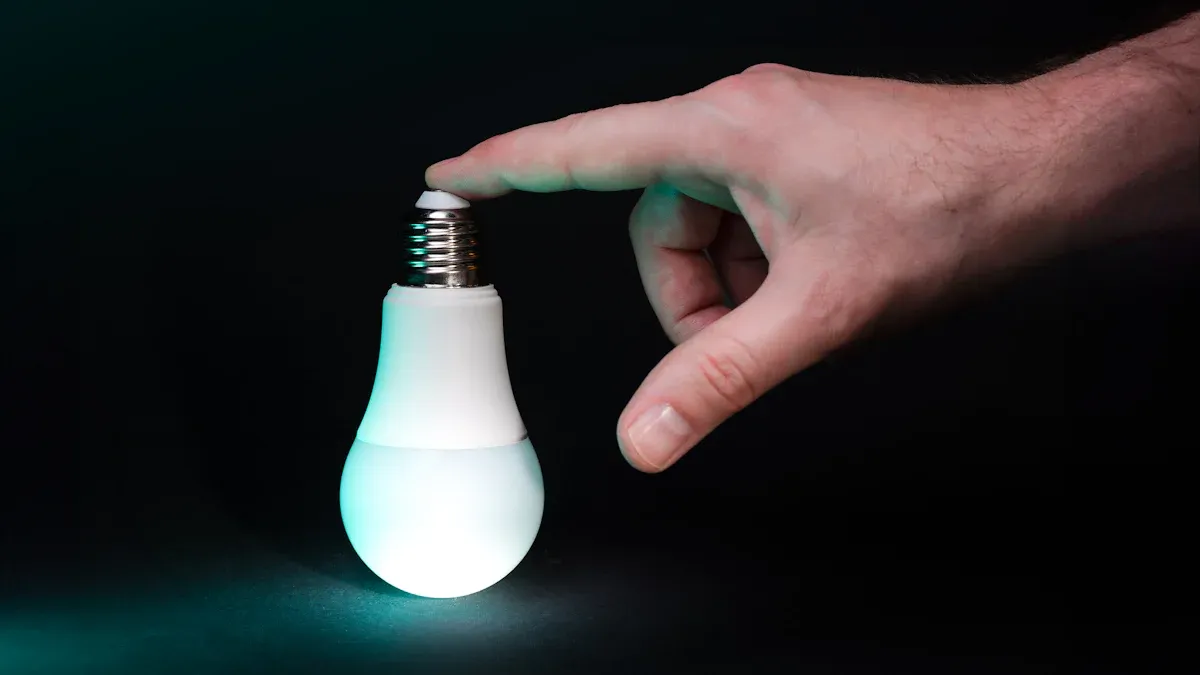
Understanding technical specifications
To choose the right LED module, know its technical details. These details show how well it works and fits your needs. Important factors include luminous efficiency, CRI, and colour temperature. These decide how the module performs in different places.
Here are key performance factors to check:
Performance Metric | What It Means |
|---|---|
Luminous Efficiency | Light made per watt of power used. |
Colour Rendering Index (CRI) | Shows how true colours look under the light. |
Colour Temperature | Tells if the light is warm or cool. |
Lifetime and Reliability | How long the module will last. |
Ingress Protection (IP) Rating | Checks resistance to dust and water. |
Dimming Performance | How well the light can be dimmed. |
Heat Dissipation | How the module handles heat. |
Lumen Maintenance | If brightness stays steady over time. |
Power Factor and Total Harmonic Distortion (THD) | Measures energy efficiency. |
Mechanical Durability | Checks how strong the module is. |
Looking at these factors helps you see a module’s good and bad points. For example, a high CRI is great for showing true colours in shops or art displays. A strong IP rating is better for outdoor or tough environments.
Matching LED modules to specific needs
Pick an LED module based on what you need it for. Different uses need different features. For example, home lights often need warm colours and low energy use. Offices or shops may need brighter, cooler lights for better visibility.
Here’s a guide to module types and uses:
Module Type | Where to Use It | Why It’s Good |
|---|---|---|
Medium-Power LED | Homes, shops, offices | Affordable, efficient, and versatile. |
Low-Power LED | Signs, decorations, building designs | Saves energy, looks nice, and is popular in growing markets. |
Customised LED | Hotels, cars, shops | Made for special needs, advanced technology, and personalisation. |
Knowing these types helps you pick the right one. Medium-power LEDs are great for general lighting as they balance brightness and efficiency. Low-power LEDs are better for decorations, using less energy while looking good.
Tips for comparing products and brands
Comparing LED modules from different brands can be tricky. Focus on important details to make it easier. Check things like pixel size, brightness, and lifespan. These affect how well the module works and lasts.
Here’s an example of what to look for:
Specification | What It Shows |
|---|---|
Pixel Pitch | 1.25mm |
Panel Dimension | 320(W)x160mm(H) |
Pixel Resolution | 256×128 dot |
Brightness | 600 – 800 cd/㎡ |
Contrast Ratio | 5000:1 |
Refresh Rate | ≥1920Hz |
Viewing Angle | 160° (horizontal and vertical) |
Lifetime | >=100000 hours |
Waterproof Rating | IP65/IP54 |
When comparing, follow these tips:
Check certifications: Look for safety marks like CE or RoHS.
Read reviews: See what users say about the product.
Look at warranties: Longer warranties often mean better quality.
Test compatibility: Make sure it works with your current system.
By doing this, you can pick the best LED module for your needs.
Avoiding common mistakes in selection
Picking the right LED module can be tricky with so many choices. But avoiding mistakes helps you find the best lighting for your needs. Here are errors to avoid and tips to prevent them:
Not checking brightness: Make sure the module gives enough light for your space. Too dim or too bright can make the area uncomfortable. For example, workspaces need brighter light than bedrooms.
Forgetting regular cleaning: Dust can gather on lights, making them less bright. Clean them often to keep the light strong and working well.
Ignoring setup instructions: Makers give clear steps for installing LED modules. Skipping these can cause problems or make the light look bad. Follow the guide to ensure it works properly and looks neat.
Not checking size and fit: Before buying, check if the module fits your fixture. A wrong size wastes time, money, and may not work correctly.
Overlooking energy ratings: Some modules seem cheap but use more power later. Choose ones with high efficiency to save money and help the planet.
Picking the wrong light tone: Different rooms need different light colours. Warm tones are good for living rooms, while cool tones suit offices. The wrong tone can feel unpleasant.
Skipping certifications: Certified modules meet safety and quality rules. Without them, the product might not last or could be unsafe.
By avoiding these mistakes, you can pick the right LED module. Taking time to choose carefully gives better lighting and long-term satisfaction.
LED modules have many benefits like saving energy and lasting long. They use less power, shine brightly, and need less fixing. This makes them a smart choice for everyday lighting. Knowing rules like BS EN IEC 62031:2020 keeps them safe to use. Features like CRI and colour temperature help you pick the best one. With new improvements, LED modules grow 8% more popular each year. Choosing wisely gives you great lighting and saves money over time.
FAQ
What makes LED modules better than old-style bulbs?
LED modules work better than old bulbs. They use less power and last longer. They also give brighter and clearer light. Unlike old bulbs, LEDs turn electricity into light without much heat. This makes them a smarter choice for modern lighting.
How can I pick the best LED module for my room?
Think about what the room is for. Warm white light is good for relaxing spaces. Cool white light works well in places where you need to focus. Check how bright the module is (lumens) and if it saves energy. Make sure it fits your light fixtures. Always read the details to find the right one.
Are LED modules good for the environment?
Yes, LED modules are kind to the planet. They use less energy, which lowers pollution. They last longer, so there’s less waste. Many LEDs follow RoHS rules, meaning they don’t have harmful stuff like mercury. Choosing LEDs helps protect the Earth. 🌍
Can I make LED modules dimmer?
Yes, many LED modules can be dimmed. But you need the right dimmer switch. Look for ones marked “dimmable” and check the details. Using the wrong dimmer might cause flickering or damage. Always check before buying.
How do I keep LED modules working well for years?
Clean them often to remove dust. Make sure they have good airflow to stay cool. Follow the maker’s instructions for setup and use. Don’t put them in places with too much heat or dampness. Taking care of them keeps them bright and lasting longer. 💡
See Also
Improving Signage Illumination With LED Light Modules
Selecting The Perfect LED Module For Your Project Needs
An Introductory Guide To Practical Uses Of LED Modules
The Advantages Of Using LED Modules For Signage
Effortlessly Illuminate Your Signs With SUNLITE LED Modules
